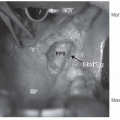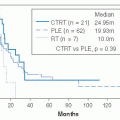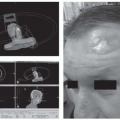Radiation Therapy Technique
Kenneth S. Hu
Louis B. Harrison
James E. Dolan
Rudolph Woode
As discussed in the body of Chapter 22, intensity-modulated radiation therapy (IMRT) has been shown to produce extremely high rates of local and regional control. Indeed, in the IMRT era, local failure for nasopharyngeal carcinoma (NPC) has become increasingly uncommon. No doubt, the ability of the radiation oncologist to encompass the entire disease extent, while maintaining protection of the adjacent vital structures, is core to the success achieved with IMRT.
IMRT also allows the opportunity for some dose reduction to the parotid glands. Care must be taken while contouring the neck nodes and the parotids because there can be nodes near the glands. In the authors’ experience, although some parotid sparing is usually feasible, it is not as complete as it is for other sites. This may reflect the authors’ conservatism in our contouring and treatment delivery. IMRT is very much physician dependent, and the authors recognize that variations in contouring and delivery will occur from one radiation oncologist to another, and from one center to another.
Figure 22-18 shows a clinical example of a patient with NPC treated with IMRT. The authors’ technique generally involves seven fields for the primary site and upper neck, matched to a low neck field. Careful contouring of the primary site (including extension to the parapharyngeal space, the skull base, and any intracranial extension), the regional lymphatics (including the retropharyngeal nodes), and nearby vital organs (the optic chiasm, the spinal cord, the brain stem, the parotid glands, and any other organ dictated by the extent of disease) are crucial.
Figures 22-19, 22-20, 22-21, 22-22, 22-23, 22-24 and 22-25 show a second patient and some added technical details. This patient is a 34-year-old Asian female who presented with rhinorrhea, epistasix, bussing in the right ear, and headache. Figure 22-19 shows the Positron emission tomography (PET)-computed tomography (CT) with the PET component beside the CT component, for ease in visual display. Disease extends into the oropharynx and involves bilateral retropharyngeal nodes. This patient was treated with IMRT. Figure 22-20 shows isodose display through the superior nasal cavity, at the inferior orbital level. Figure 22-21 shows a CT cut and isodose display at the level of the maxillary sinuses. The skull base, the superior nasal cavity, the maxillary sinus, and the pterygopalatine fossa were included in the intermediate risk CTV and treated to 5,400 cGy in 6 weeks. The temporal lobes and the brain stem are contoured in Figure 22-20 and the right cochlea is seen in Figure 22-21.
Stay updated, free articles. Join our Telegram channel

Full access? Get Clinical Tree








